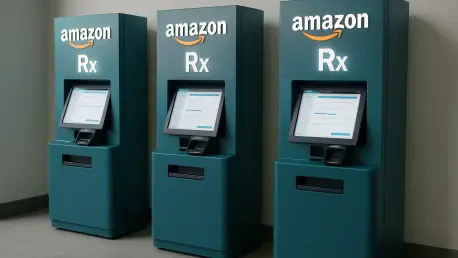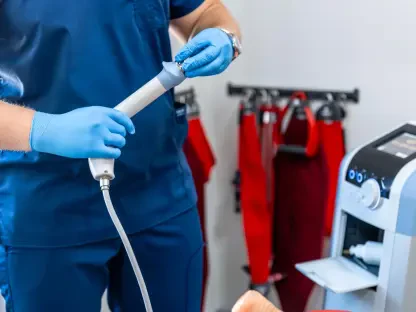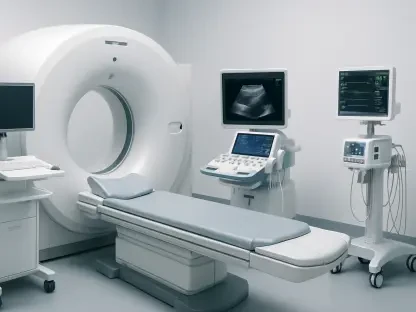Setting the Stage for a Healthcare Revolution
Picture a world where a patient leaves a doctor’s office with their medication in hand, bypassing the traditional pharmacy wait times and logistical hassles. This scenario is no longer a distant dream but a reality unfolding through Amazon Pharmacy’s innovative prescription kiosks at One Medical clinics. With medication non-adherence costing the healthcare system billions annually, this strategic move by Amazon targets a critical gap in patient care. This market analysis delves into the transformative potential of these kiosks, examining their impact on current trends, competitive landscapes, and future projections within the healthcare sector. By addressing accessibility and convenience, Amazon is poised to redefine how medications are dispensed and consumed, setting a new benchmark for the industry.
Dissecting Market Trends and Strategic Impacts
Unveiling a New Frontier in Medication Access
The healthcare market is witnessing a seismic shift with Amazon’s introduction of prescription kiosks at select One Medical clinics in the greater Los Angeles area, starting in December of this year. These kiosks, designed to dispense common medications like antibiotics and blood pressure drugs within minutes, directly tackle the pervasive issue of medication non-adherence. Studies indicate that nearly half of patients with chronic conditions fail to follow prescribed treatments, often due to barriers like inconvenient pharmacy locations or prolonged wait times. Amazon’s solution integrates pharmacy services into primary care settings, ensuring immediate access that could significantly enhance patient outcomes, particularly for acute conditions requiring prompt intervention.
This initiative aligns with a broader market trend toward patient-centric healthcare solutions. The ability to pick up medications at the point of care not only addresses logistical challenges but also taps into growing consumer demand for seamless experiences. As healthcare providers and retail pharmacies grapple with rising costs and inefficiencies, Amazon’s model offers a glimpse into a streamlined future. However, limitations such as the exclusion of controlled substances and refrigerated medications due to regulatory constraints highlight potential gaps that competitors might exploit in niche segments.
Redefining Competitive Edges in Pharmacy Services
Convenience and speed are emerging as pivotal differentiators in the pharmacy sector, and Amazon is capitalizing on these priorities with its kiosk rollout. Industry analysts note that location and rapid fulfillment rank high among consumer preferences when selecting a pharmacy, assuming cost and insurance coverage are comparable. By embedding dispensing units directly in clinics, Amazon eliminates the need for separate pharmacy visits, outpacing traditional brick-and-mortar stores and even mail-order services in terms of immediacy. This strategic positioning could reshape consumer expectations, pushing competitors to innovate or risk losing market share.
The competitive landscape is further complicated by Amazon’s ability to leverage its vast logistical expertise and technology infrastructure. While traditional pharmacies rely on established networks, they often lack the agility to match this level of integration. Scaling such a model nationwide, however, may encounter obstacles like varying clinic capacities and patient volumes. Despite these challenges, the potential for Amazon to set a new standard in retail pharmacy services is evident, signaling a shift toward on-demand healthcare that mirrors the ease of e-commerce.
Navigating Regulatory and Regional Market Challenges
As Amazon expands its kiosk program, regional disparities and regulatory frameworks introduce layers of complexity to the market dynamics. The initial pilot in Los Angeles may not fully represent the challenges of rural or underserved areas where clinic infrastructure and patient demographics differ significantly. State-specific healthcare regulations could also impede expansion plans slated for early 2026, requiring tailored approaches to comply with local mandates. This variability underscores the need for adaptive strategies that incorporate digital tools or partnerships to bridge gaps in less accessible markets.
A common misconception is that technology-driven solutions like these kiosks will entirely replace traditional pharmacies. In reality, they serve as a complementary offering, focusing on a limited range of medications. Competitors in the pharmacy space must recognize this distinction and explore hybrid models to remain relevant. Amazon’s success will likely hinge on its ability to balance innovation with compliance, avoiding pitfalls seen in past healthcare ventures that struggled to scale amid regulatory or operational hurdles.
Projecting the Future of Healthcare Markets
Looking ahead, Amazon’s prescription kiosks signal a broader market evolution toward integrated, technology-driven healthcare solutions. Emerging trends point to a future where pharmacy services embedded in primary care settings become standard, fueled by advancements in automation and digital platforms. Economic pressures, such as escalating healthcare costs, are likely to drive providers and payers to adopt similar models to curb overhead expenses while improving patient outcomes. Projections suggest that by 2027, a significant portion of primary care facilities could incorporate on-site dispensing, reshaping market expectations.
Regulatory landscapes remain a critical variable in this forecast. Stricter guidelines around in-office dispensing or data privacy could slow adoption rates, while supportive policies might accelerate growth. Amazon is expected to experiment with blended approaches, combining kiosks with telehealth and home delivery options to create a comprehensive care ecosystem. Such innovations could redefine competitive benchmarks, positioning technology giants as central players in a market traditionally dominated by healthcare-specific entities.
The long-term market impact of these kiosks extends beyond immediate convenience. They could catalyze a shift in consumer behavior, normalizing expectations for instant access across healthcare services. Competitors will need to invest in digital transformation and strategic alliances to keep pace, while smaller pharmacies might face increased pressure to consolidate or specialize. As this landscape evolves, Amazon’s influence could drive a fundamental reimagining of how healthcare delivery aligns with modern consumer demands.
Reflecting on Strategic Pathways Forward
Looking back, the rollout of Amazon’s prescription kiosks marked a pivotal moment in the healthcare market, spotlighting the intersection of technology and patient care. The analysis revealed significant strides in addressing medication adherence and redefining convenience, while also uncovering challenges tied to regulatory and regional nuances. For stakeholders, the path forward involves prioritizing strategic partnerships and technological investments to match Amazon’s innovative edge. Healthcare providers can adapt by exploring integrated dispensing solutions, while pharmacy businesses should focus on localized services to retain customer loyalty. The enduring lesson is clear: adaptability and patient-centric innovation are essential to thrive in a market reshaped by such disruptive advancements.









